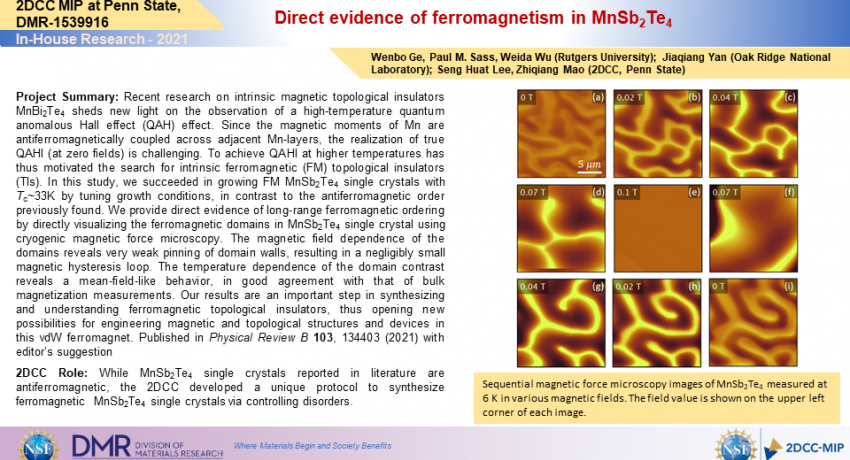What Has Been Achieved:
A ferromagnetic (FM) phase of MnSb2Te4 has been demonstrated via magnetic force microscopy magnetic domain imaging. This phase is found to be sensitive to disorders and can be stabilized via controlling disorders.
Importance of the Achievement:
This work is not only an encouraging step towards realizing a FM topological insulator but also stimulate future studies to understand and control the synthesis conditions that lead to different magnetic orders in the Mn(Bi,Sb)2nTe3n+1 family and further explorations of their topological and magnetic properties.
Unique Feature(s) of the MIP that Enabled this Achievement:
The 2DCC developed a unique protocol to synthesize ferromagnetic MnSb2Te4 single crystals via controlling disorders. The level of disorders is found be tunable via adjusting thermal treatment conditions.
Publication:
Wenbo Ge, Paul M. Sass, Jiaqiang Yan, Seng Huat Lee, Zhiqiang Mao, and Weida Wu, Physical Review B 103, 134403 (2021). DOI:10.1103/PhysRevB.103.134403
The MFM studies at Rutgers are supported by the Office of Basic Energy Sciences, Division of Materials Sciences and Engineering, U.S. Department of Energy under Award No. DE-SC0018153. Work at ORNL was supported by the U.S. Department of Energy, Office of Science, Basic Energy Sciences, Materials Sciences and Engineering Division. Support for crystal growth and characterization at Penn State was provided by the National Science Foundation through the Penn State 2D Crystal Consortium-Materials Innovation Platform (2DCC-MIP) under NSF Cooperative Agreement DMR-1539916.
Credits/Names: Wenbo Ge, Paul M. Sass, Weida Wu (Rutgers University); Jiaqiang Yan (Oak Ridge National Laboratory); Seng Huat Lee, Zhiqiang Mao (2DCC, Penn State)
Download PDF Version: 1539916_2DCCMIP_2021_Direct evidence of ferromagnetism in MnSb2Te4.pdf
Year of Research Highlight: 2021
Select a Highlight Type: In-House Research Highlight
